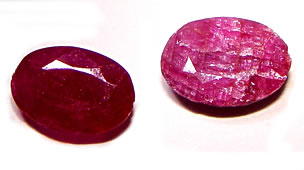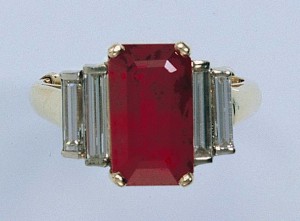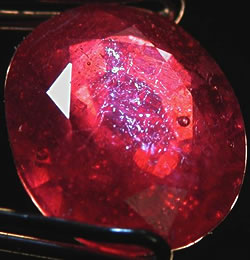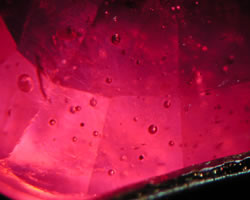When I first published this article in 2010, glass-composite rubies had become a rampant consumer threat. My source Antoinette Matlins was seeing them everywhere, including at mainstream retail chains, passed off as natural rubies. Yet most jewelry buyers had never heard of them.
More recently, Wim Vertriest, GIA Field Gemology Manager brought up glass-composite rubies at the Hong Kong International Jewellery Show in March 2025. The GIA, he said, now labels rubies that have as much or more glass than gem content not as “treated rubies” but “manufactured products.”
“How much glass can you put into a ruby? A lot,” he said, showing a slide of a ruby a client had brought in claiming it was “pigeon blood ruby” from his grandmother, that turned out to have more glass content than ruby. Put into jeweler’s pickle, with the client’s permission, the “stone,” which looked like a lovely, deep red oval-cut ruby, disintegrated into pink sand.
Vertriest urged dealers to be more transparent about gem treatments in general, but this one in particular. “‘This is probably the easiest treatment to recognize but the mistake you make in not recognizing it is enormous,” he said.
This was the precisely the point Matlins was making in 2010, and her descriptions still hold. Here is what she had to say about glass-composite rubies — or, as the GIA would now call them, manufactured rubies:
Antoinette Matlins on glass-composite rubies
With the third edition of Colored Gemstones: The Antoinette Matlins Buying Guide , gem and jewelry expert Antoinette Matlins caught me up on the latest developments in colored stones. The most important change has to do with gem treatments, in particular the introduction of composite ruby, a glass mixture which is being sold globally as genuine ruby. If you’re in the market for rubies, read on before you buy.
How bad has this trend become?
Antoinette Matlins: It is bad. There is rarely a day that goes by without my getting a call from somebody, a consumer or another gemologist who wants me to explain this problem to the person crying at their desk because they paid thousands for a stone that’s probably worth $100.
The real problem is that this material is being confused with natural rubies that have been treated in some way, either fracture-filled with glass or treated with high heat which creates a glass residue.
And these gem treatments are not necessarily bad?
AT: Not necessarily bad. “Treated” ruby starts out as ruby, a single crystalline structure of red color that’s been cut and polished. The color and clarity can be improved through various treatments, and these treated stones are priced appropriately for those treatments.
Natural, untreated ruby is extremely rare and one of the most expensive stones in the world.
As the world’s ruby sources became depleted, treatments were introduced that would provide lovely rubies at more affordable prices. The earliest treatment – and one still used – involves heating with low to moderate heat. Nothing is added to the stone. In some ways, it simply extends the natural process. These are the most expensive of the treated stones and can still cost thousands of dollars per carat.
Later, high-heat techniques were introduced that were a bit more affordable. High-heat techniques that left a residue of glass in fissures were even more affordable. Most recently, a treatment was introduced using glass to fill unsightly fractures so they become less visible. These are more affordable yet – and so on.
But because there are ruby treatments where the word “glass” appears, it has led to tremendous confusion about this newcomer, which is produced by totally different methods.
What exactly is a glass-composite ruby?
AT: It starts with material that is extremely low-grade corundum (the mineral known as ruby when red, sapphire when blue or any other color). There is some question as to whether it started out red or pink – thus, whether you can even call it ruby. It starts out as a rock containing multiple entwined crystals, interlaced with other extraneous minerals, rather than a single crystal with a nice color and good transparency.
The treaters leach out all of the surrounding extraneous material from the host rock leaving this tangled mass of low-grade corundum. This material is very porous, not a single structure, so it needs the glass to hold it together in order to cut it.
At a minimum, stones I’ve examined were approximately 15 percent glass. But some I’ve seen lately are pushing 50 to 60 percent glass. Some labs are calling them “composite rubies,” some are calling them “glass ruby composites,” some “hybrid rubies.” By whatever name, there is universal agreement that these are not, and should not be sold as, genuine ruby. There is no universal agreement, however, on what they should be called. That’s where the issues are currently creating consumer problems.
How can buyers spot a composite ruby?
AT: If they have a 10x jewelry loupe and know how to use it, they can easily and quickly see telltale indicators. When the surfaces are viewed in reflected light, you can see lots of intersecting lines looking something like a spider web or a fingerprint where the glass is holding things together.
If you view a ruby composite with light coming through the stone, you can also see a significant number of glass bubbles — some quite large, some smaller — through the entire crown or pavilion. That’s how you know the stone is a composite.
Sometimes you can also see some yellow color, because they frequently use yellow tinted glass to make certain shades of red look redder. That is an indication of where some of the glass is.
What else can consumers do to protect themselves?
AT: Ask the person you’re buying from straight out: “This is not one of those glass composite rubies, is it?” They should be willing to write “This is a genuine ruby, not a composite” on the sales receipt. Because that’s what they told you. If they’re not willing to put that in writing, my advice is: Run, do not walk, run to another source, because this one is not reliable. He or she is either ignorant or dishonest. Those are the only two possibilities.
Are these composites being sold by mainstream retailers?
AT: They’re being sold at Macy’s. I did a segment on this for Good Morning America in December because Macy’s was selling “ruby” jewelry for $3,400-5,000 when thewholesale value of the stones was less than $100. I don’t believe Macy’s buyers have done it knowingly, but a lot has come out about these composites in the trade press since then. I went into a Macy’s a few weeks ago and that jewelry was still there.
Is there a place for composite rubies?
AT: I think there’s a market for it. It looks more like real ruby than most synthetic rubies do, so it gives somebody who can’t afford a ruby a wonderful alternative. I wouldn’t recommend mounting them in gold and diamonds but set in sterling or plated metal, maybe surrounded by CZs, and you’d have a very pretty, very inexpensive piece of jewelry.
I noticed today that JTV is selling this, calling it “hybrid ruby” and explaining what it is. They’re pricing it at a few dollars a carat, about $50-74 per stone. At that price, it’s one thing. At $1000 or $2000 or $5000, it’s a totally different thing. Apparently, when you buy this from JTV, you get a booklet that tells you what it is and how to care for it. Take it off before you do the dishes, for example, because Dawn dish-washing detergent will destroy it. So will lemon juice and any number of household chemicals.
Find out more about ruby composites and other gemstone treatments in the latest edition of Colored Gemstones: The Antoinette Matlins Buying Guide.
Related posts
JAR in full flower: 18 rare jewels on the block
Season of JAR: a connoisseur’s approach to gems
How to spot fake gems in old jewels
This page contains affiliate links. Using them puts a buck or two toward maintenance of this site.





